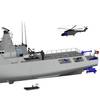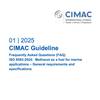Texas Maritime Academy Ship Simulator Attracts All Levels
Mike Kemp, vice president and CEO of the campus, said this funding will significantly assist the university in complying with operational standards and technological requirements established by the International Maritime Organization (IMO) and the U.S. Coast Guard (USCG). The Texas Maritime Academy is one of only six in the U.S. and the only one on the Gulf Coast. The improvements to its maritime program ensures TAMUG cadets will receive first-class, advanced training that is equal to or better than other maritime academies, said Rear Admiral Richard Lukens, superintendent of the Academy. "The Board of Directors approved this grant given the unique nature of the university and the increased need for talented professionals in the maritime industry," said Ann Hamilton, Houston Endowment grant officer. "We are pleased to be a part of shaping the future of young people entering this field of study."
The ship simulator will also be available to maritime professionals for upgrading their navigation skills through a partnership with the Center for Marine Training and Safety (CMTS). The Full Mission Ship Simulator is a highly computerized replica of the control room, or "bridge" of a seagoing vessel. It realistically duplicates weather and sea conditions experienced while at sea and provides hands-on training in ship handling and navigation skills.
The Academy's new simulator provides the opportunity to address some economic developments, as both Houston and the State of Texas become a trading powerhouse for the Gulf coast and the country.
Historically, the northeastern U.S. has provided a large percentage of support for maritime shipping, the most economical method for shipping goods.
However, the ports, waterways and roads of the region are saturated and cannot accommodate increased traffic. The southeastern U.S. ports and waterways are the logical place to funnel increased traffic. Texas especially has plenty of landslide access to its ports and is positioned perfectly to handle increased trade from the south with Mexico, Central America and South America as was envisioned with NAFTA.
Another major economic affect the simulator will have is on the oil exploration industry. Industry estimates derived from a study by Mitchell Energy and Development state that $400 billion will be spent over the next 40 years in deep sea drilling in the Western Gulf. Texas will be a major focal point of investments in oil exploration, transportation and refining.
Training Capabilities
The simulator's software is capable of modeling a full range of commercial vessels, from harbor tugs to fully loaded crude oil carriers, and can be upgraded to include new ship types and specialty marine vehicles. The upgraded simulator also includes software for two new mission specific simulators — a Global Maritime Distress and Safety System (GMDSS) and an Electronic Chart Display and Information System (ECDIS) that provide state-of-the-art equipment to train and certify cadets in GMDSS operations and to prepare cadets for use of electronic charts in ship navigation. According to Lukens, ECDIS certification is not currently mandated by the IMO/USCG, but will be required in the near future.
TAMUG and CMTS students have the opportunity to become certified before the ECDIS qualification becomes mandatory. The new equipment also offers training opportunities in inland and intra-coastal waterways, including tug and tow and similar brown water operations.
The $2.2 million Texas Maritime Academy budget includes ship operations, marine terminal operations, simulator operations and faculty and staff costs. The Houston Endowment grant will be applied toward the total $846,655 simulator upgrade and relocation project, which also received funding through university budget allocations and gifts by corporations and individuals.














